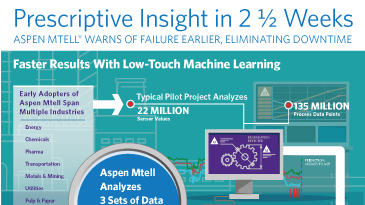With all the advances we’ve seen in automotive technology – from electric cars to automatic braking systems to the dawn of self-driving vehicles — it’s amazing that so much of our maintenance warning still hinges on one simple indicator: the dreaded “check engine” light.
What does that amber-colored light mean when it comes on? Nobody really knows, unless you go to the trouble of hooking up a code reader and then deciphering a trouble code that may or may not provide any real information. So what’s the normal course of action for many of us? Just keep on driving, and hope it shuts off eventually — light’s off, we’re all good now!
Of course this is no way to handle a maintenance process, and at the capital-intensive customer organizations I work with, they are starting to realize that they need more than the equivalent of a “check engine” light to assure reliability. They’ve discovered that traditional preventive maintenance alone cannot solve the problems of unexpected breakdowns. Prescriptive maintenance, on the other hand, creates the opportunity to mitigate the negative impact of unplanned events by recommending action in advance the failure.
Data-Driven Insight Changes the Approach
The key to taking effective action before breakdowns occur is tapping into the process and equipment data that your asset generates every second of every day. With asset performance management (APM) powered by low-touch machine learning, it’s now possible leverage decades of design and operations data to generate prescriptive maintenance solutions and optimize asset performance.
This is disruptive technology that can change the game for complex facilities across industries. Aspen Mtell®, for example, uses plant data to deploy accurate, precise failure pattern recognition to predict equipment breakdowns months in advance.
All of this is driving a move from the old way of approaching maintenance (creating detailed models of asset behavior) to the new way (identifying the “signatures” of failures). At AspenTech, we’ve worked with numerous clients to complete pilot APM projects in their facilities.
These pilots are demonstrating the value of a new approach to improving asset effectiveness. Consider a few of the benefits of implementing a comprehensive APM program based on prescriptive analytics:
-
Organizations are getting their solutions in place quickly, generating real results in an average of just 2 ½ weeks.
-
This speed is driven by a low-touch machine learning approach that eliminates much of the manual effort typically involved in “data wrangling.”
-
Also, the autonomous agents that power Aspen Mtell do more than provide standard anomaly detection. Instead, they identify specific failure signatures across the asset. This is the early-warning system that prescribes maintenance action well before equipment fails.
Early, Accurate Warnings Deliver Reliability
The bottom line is, this new approach to APM through prescriptive maintenance finds problems sooner than other technologies, and it takes faster action to correct the problems. What makes the difference is the accuracy of failure signatures over standard anomaly detection. Anomaly detection is essentially the “check engine” light — it tells you something is different, but it’s still up to you to determine what.
If you’d prefer to run your facility with the most accurate, advanced and specific warnings of failures — enabling you to maximize uptime and profitability — it’s time to explore a maintenance solution that leverages prescriptive analytics.
To learn more about how advanced APM technology is driving optimum reliability for a number of early adopters, check out the recent white paper Seeing Into the Future With Prescriptive Analytics: A New Vision for Asset Performance Management.





Leave A Comment